You’ve probably heard of the Cetina River Eye in Croatia. It’s a freshwater spring that looks like an eye when seen from above. The lake is located at the river’s end, flowing through a cave before emerging into the open air.
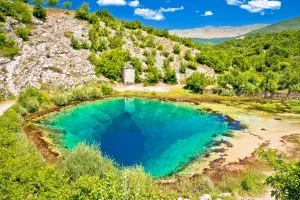
The name “eye” comes from its shape, which resembles an eyeball. Visitors are surprised by how clear and deep the water is. They expect it to be muddy and brown like most rivers. The Cetina River Eye isn’t just beautiful; it also has some fascinating history behind it.
About the Cetina River Spring
The Cetina River Spring (Izvor Cetine), also known as the Eye of the Earth, is a breathtaking karst spring in Croatia’s Dinara mountain range.
The Eye Of The Earth in Croatia got its name because it appears above to be a blue-green dragon eye. The Izvor Cetine source is a beautiful hidden gem in Croatia. It ranks first among Croatia’s most notable and unique locations.
It’s one of those best places to go hiking, swimming, and kayaking while enjoying the stunning views. If you’re looking for something different than the usual beach vacation, try visiting this fantastic place!
The average temperature of Cetina River Spring
The average temperature of Cetina River Spring is 15.2 °C (59.4 °F). This is precisely the same as Croatia’s national average. However, this value varies greatly depending on the location.
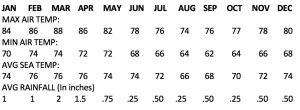
The average annual temperature in the country is 17 °C (62.6 °F). The highest ever recorded was 39 °C (102 °F), and the lowest ever recorded was -13 °C (8.6 °F).
Cetina River Spring: Where Is It Located?
Cetina (pronounced [tstina]) is a river in southern Croatia. It is one of the famous landmarks of continental Croatia. It is 101 kilometers (63 miles) long and has a basin area of 1,463 kilometers (565 sq mi). Cetina flows to the Adriatic Sea from its headwaters 385 meters (1,263 feet) above sea level. It is the most water-rich river in Dalmatia.
The Spring of Cetina is at an altitude of 1,065 meters (3,493 feet) on the slopes of Mali Gradac mountain. It is close to Smiljevica village, on the road from Sinj to Omiš. Beech trees and bushes with wild strawberries surround the Spring.
The water comes from a small cave between rocks. Also, it looks like it’s still coming from underground water springs. The smell of sulfur comes from this water. But it can’t be seen because the smell disappears as soon as you pour it into glasses or bottles. You can spend your long weekend here in these beautiful Croatian Islands.
Where is the source of the Cetina River?
The river rises from two sources. One is the Veliki Lug area on the western slopes of the foothills of the Dinara mountain range, near Omiš and Velika. The other one is at Plitvice Lakes National Park near Jasenovac, which forms an extensive karst spring of many small and large springs.
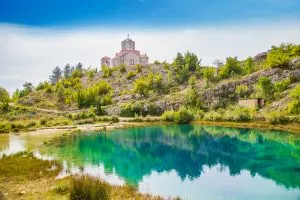
The Cetina flows through the karstified limestone terrain. This provides excellent conditions for the development of caves and underground streams. It also has several tributaries, including the Krka River, Orljava River, and others. Its largest tributary is the Krka River which forms a powerful waterfall at Skradinski Buk near Skradin town.
What is a Karst Spring?
Karst springs are springs that have their source in karst terrain. They are often essential for agriculture and other human activities. This is because they provide drinking water and are used for irrigation. Many are also the primary surface water source for the adjacent watershed.
Karst springs come from the subsurface limestone layer through cracks or joints in the rock massif. At the surface, water flows out through an opening called a spring vent or emergence point. The flow rate of a karst spring is highly variable.
It depends on seasonality, weather conditions, and local geology (e.g., the permeability of rock layers). The term “karst spring” can be applied to any spring emerging from karstic aquifers (aquifers formed by dissolution processes).
However, this article focuses only on those that arise from limestone. In addition to these geologically-related karst springs, some are created by human activity. These are generally called “manmade karst springs” or simply “manmade springs.”
How to get to Croatia’s Cetina River Springs?
The Cetina River springs are located in the Kordun region of Croatia. The river is about 50 km long and flows through the region of Lika, emptying into the Adriatic coast at Novalja on Peruća Bay.
Unfortunately, no tours to Cetina are available from any of the Dalmatian Coast’s popular tourist cities. This means you’ll have to drive yourself if you want to see this incredible natural attraction. Fortunately, renting a car in Croatia is very cheap, mainly if you use rental comparison sites like DiscoverCars.
![Cetina river Spring with landscape view, Cetina River Spring, Cetina River Spring: Where Is It Located? Cetina (pronounced [tstina]) is a river in southern Croatia. It is one of the famous landmarks of continental Croatia. It is 101 kilometers (63 miles) long and has a basin area of 1,463 kilometers (565 sq mi). Cetina flows to the Adriatic Sea from its headwaters 385 meters (1,263 feet) above sea level. It is the most water-rich river in Dalmatia. The Spring of Cetina is at an altitude of 1,065 meters (3,493 feet) on the slopes of Mali Gradac mountain. It is close to Smiljevica village, on the road from Sinj to Omiš. Beech trees and bushes with wild strawberries surround the Spring. The water comes from a small cave between rocks. Also, it looks like it's still coming from underground water springs. The smell of sulfur comes from this water. But it can't be seen because the smell disappears as soon as you pour it into glasses or bottles. You can spend your long weekend here in these beautiful Croatian Islands,.Croatia in Spring](https://www.pointsandtravel.com/wp-content/uploads/2022/02/Cetina-River-Spring-300x200.jpg.webp)
After renting a car, enter “Cetina River Spring” or “Izvor Cetine” into your navigation app to easily find it along Highway 1. Following a narrow road, you will arrive in the small village of Cetina after taking the right turn exit at Restaurant Ivan. Soon after, you’ll notice a small parking area and viewpoint area next to the Serbian Orthodox Church of the Holy Salvation.
Dubrovnik to Cetina River Spring
The road from Dubrovnik to the Cetina River Source is a scenic drive through Bosnia and Herzegovina. The road is not well signposted, so you must be prepared for some backtracking if you miss a turn. The drive takes about 3,5 hours without traffic, but if there is traffic, it can take much longer.
The road trip starts at the east end of Dubrovnik, which meets the coastal area highway D8. From here, it follows the coast until it reaches the border with Bosnia and Herzegovina. This part of the drive is one of my favorite parts of Croatia – beautiful!
As you approach the border, you’ll see signs for Bosnia and Herzegovina on your left side. Drive past these signs (Bosnia has different rules for tourists driving in their country) and continue down this road toward Trpanj.
Split To Cetina River Spring
Split is the second-largest city in Croatia. It is located on the eastern shore of the Adriatic Sea, centered around the Roman Palace of Emperor Diocletian or Diocletian’s palace (the most important archaeological site in Croatia).
The first thing that comes to mind when you think of Split is probably its beach. The most popular one is Bačvice, a beach area with many nearby bars and local restaurants.
It is much faster to get from Split to the Cetina River Spring. Without traffic, it only takes 1.5 hours, and there is no border control. The road is narrow and curvy but in good condition. If you are driving a car, ensure you have enough tire pressure as there are many potholes along the way.
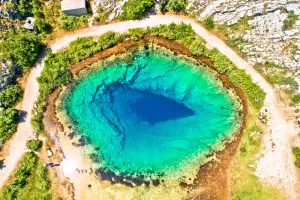
Several companies offer transportation from Split to River Cetina if you don’t have a car or don’t want to drive yourself. You can book them online or ask your hostel staff for recommendations.
If you’re not too keen on spending your day lounging on one of the amazing beaches, we recommend visiting Split’s historic old town, which dates back to Roman times. Its narrow streets are filled with restaurants and shops selling local products like olive oil and local wines, including the oldest wine.
The best way to experience this part of the coastal town is by walking through it — no cars are allowed here! You can rent bikes at any hostel or hotel to get around quickly.
What to expect at the Eye of the Earth in Croatia?
As soon as you arrive at the viewpoint, you’ll understand why Cetina River Spring’s Eye of the Earth got its name! The river is crystal clear and surrounded by cliffs that make it look like a giant eye staring at you from below.
The view from this spot is breathtaking, but there are many other exciting things to see along the road leading to it. You’ll first notice a large rock formation called Veliki Slap (Big Cliff) on your left side. It’s about 200 meters high and one of Croatia’s most popular places for climbing.
At this point, you’ll also see some abandoned houses that have been left behind by people who used to live here until recently. Some people still live in the area, but most moved away when the dam was built nearby (which created Lake Vrana).
This was done because they needed more space for farming and breeding livestock due to increased tourism on this part of Cetina River Valley Road.
When is the best time to visit Croatia’s Eye of the Earth?
To begin, from a tourist’s perspective, a year can be divided into three categories. The three seasons are off-season (low season), shoulder season, and peak season (high season).
The peak season, which runs from mid-June to mid-September, is the best season. The main disadvantage of this is that there are many people and it can be crowded. Although many people consider those months ideal for vacation, you may not. The ideal time to visit the Eye of the Earth is summer when mild temperatures and there are smaller crowds.
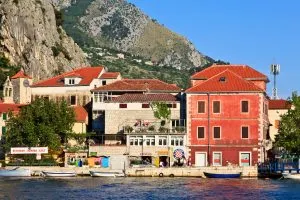 The coolest months in Croatia are January and February. Temperatures during this time of the year can get as low as -5°C (23°F), so bring a good coat for winter snow. In early springtime (early March to late April and late May), temperatures rise and reach as high as 30°C (86°F).
The coolest months in Croatia are January and February. Temperatures during this time of the year can get as low as -5°C (23°F), so bring a good coat for winter snow. In early springtime (early March to late April and late May), temperatures rise and reach as high as 30°C (86°F).
This is also a good time for hiking in the mountains or along the coast, where you can see wild asparagus in the area. You will also experience cultural events in late Spring like the Ston Oyster Festival, where you can taste the best oysters in town.
In summer (early June to August), high temperatures rise, often hitting 35°C (95°F). It’s not just hot but also exceptionally humid, with almost no rain throughout July and August. This is an excellent time for people who love the sun.
Autumn (September to November) is another great time for exploring Croatia, with warm weather but more relaxed evenings. It rains intermittently throughout this season, but there are still plenty of sunny days.
How to Enjoy Your Stay in Cetina River Spring?
Enjoying the Cetina River is an actual Croatia experience. The river is clear and clean, and it’s possible to see fish swimming. It is one of the popular destinations due to its natural beauty and great potential for water sports such as rafting. In addition, it offers many different courses, depending on the level of difficulty you want to experience.
You can swim in the water in most areas – but don’t go too far from the shore! There are some deep parts of this river where you could quickly get stuck or even drown. The best way to enjoy the Cetina River is to swim in it or go boating or kayaking. It’s great fun!
The bicycle tour begins at the Hotel Alkar in Sinj. From here, you will ride towards the village of Panj. You will cross the Cetina River here. Furthermore, the tour will take you down Macadam Road. It will take you through Perua Lake’s unspoiled areas.
On your way to the Church of the Holy Salvation, you will also pass through the breathtaking Dinara mountain foothills. It has been around since the 9th century. Meanwhile, after 500 meters, turn right to reach the Spring of the Cetina River.
After eating and taking photos, you can take the main tourist or popular route back to the hotel. Aside from that, you can swim in Lake Perua, located in the Dubar village. Of course, to fully enjoy the beauty of this small body of water, you need to have travel insurance to keep you secure.

Tips for taking pictures in Cetina River Spring
Cetina River Spring is one of the most beautiful places in Croatia, and it is a must-see if you are traveling to Dalmatia. A lovely river flows through the cave, and there are many opportunities for taking amazing photographs.
Here are some tips on taking good photos in this magical place.
-
Use A Tripod
A tripod is highly recommended if you want your pictures to be sharp and clear. It will help you eliminate the blurriness that can result from shaking hands. Also, for poor camera settings when taking pictures in low-light situations.

2. Use A Wide Angle Lens
A wide-angle lens will allow you to capture more of the scene in front of you. This includes more elements into your picture while keeping it balanced and not too busy. This also makes it easier to fit everything into one shot without zooming out or cropping later after taking the picture.
3. Bring a polarizing filter (CP)
A circular polarizer works similarly to a polarizer in your sunglasses to effectively remove glare. This is great for the Eye of the Earth because you’ll get more precise shots without glare or cloud reflections. You can get one for your camera or your drone.
4. Use The Right Settings
If you’re using an automatic mode on your camera, make sure you switch to manual so you can fully control your settings. This way, you’ll be able to set the ISO, aperture, and shutter speed properly so that you can get the best possible shot every time!
5. Use a drone
It’s safe to say that this is primarily a drone-flying location! From above, you’ll get some of the best shots of this natural eye.

Where can I stay near the Cetina River? (Izvor Cetine)
Are you looking for more things to do in Croatia’s Dinara Mountain region? Here are a few top-rated options in the area.
Villa Cetina
Villa Cetina is a lovely villa near the river’s headwaters beneath Dinara Mountain. It has been designed as a modern contemporary building with all amenities you will ever need.
The house comprises three bedrooms, two bathrooms, a living room with a fireplace, and a kitchen equipped with all necessary utensils for cooking. There is also a spacious terrace where you can enjoy your meals and the views of the surrounding mountains.
Nature and fresh air surround Villa Cetina. You will be able to see the beauty of nature from every window in the house! It is very peaceful where you can relax after a long day of sightseeing or a business trip.
It has its own private parking space, which can accommodate up to 4 cars or even more if necessary! Also, there are plenty of other parking spaces around the villa, so there should be no problem finding one when needed!
Villa Leko Dream House
Villa Leko Dream House is one of the most beautiful villas in the world. It is located in Cetina River Spring, an amazing place between mountains and the sea.
The villa has a beautiful view of the Cetina River and the surrounding area. You can see everything from there, including the sunset. Also, it has a private pool and an outdoor Jacuzzi with a fantastic sea view.
There are three bedrooms with king-size beds, as well as two bathrooms. The main bedroom also has a terrace with a hot tub. You can enjoy your morning coffee from there while watching the sunrise over the sea!
The living room is spacious and comfortable, with a fireplace and large windows that let in lots of light during the day and make it look even more prominent at night when lit up from inside.
Hotel Alkar
Hotel Alkar is a popular hotel near Sinj village, only 40 minutes away. It offers comfortable accommodation and a wide range of facilities and services to suit your needs.
Hotel Alkar is located in the small village of Jasenak, just five minutes from the historical town of Sinj. It is surrounded by beautiful nature and greenery that will make you forget about the hustle and bustle of modern life and enjoy some peace.
The hotel has spacious rooms with air conditioning, satellite TV, free Wi-Fi internet connection, and a private bathroom with toiletries. You can also enjoy your meal in our restaurant, which serves traditional Dalmatian hinterland home cooking prepared daily by our chefs using local producer’s ingredients.
They offer you a variety of outdoor activities in the hotel, such as cycling tours around Sinj or kayaking on the Krka River or visiting the Krka national park with spectacular views of beautiful nature around you.
Kijevo Holiday Home
A highly-rated vacation rental on a private lot just 5 minutes from the Eye of the Earth. This is the right place for those seeking a quiet and peaceful vacation and those who want to enjoy the nightlife and entertainment nearby Novi Sad.
The kitchen includes a dishwasher and oven. In addition, there is a barbecue place on the terrace where you can grill fresh fish caught with your fishing rod! The house comprises of all-natural materials (stone, wood, glass). The garden around it consists of various fruit trees that provide fresh fruit for your enjoyment during your stay at Kijevo Holiday Home.
The house has two floors and a total area of 120 square meters. It consists of 3 bedrooms, two bathrooms, kitchen with dining room and living room with fireplace. The ground floor has a large terrace with a barbecue; upstairs, two balconies with fantastic views over the small Lake Kneževac.
More Information About Cetina River Spring
How deep is the Cetina River Spring?
The Cetina river source is a popular tourist attraction in Dalmatia. It is located in the town of Omis, which is about 40 km north of Split. It’s about 60 meters deep and has an area of about 5,000 square meters.
The Cetina river source is famous for its clarity and cleanliness. The water from this source is not only for drinking but also for agricultural purposes. Also, it is one of the cleanest and most beautiful sources in Europe.
What is the temperature of the water at the Eye of the Earth?
The water temperature at the Eye of the Earth is freezing. The signs near the beautiful Spring indicate that the water temperature brought from the depths of the earth is as low as 4 to 8 degrees Celsius (39 to 46 degrees Fahrenheit).
The water here flows at a rate of 30 liters per second, which means it has been underground for a long time before being brought back up to the surface and bottled for sale in stores.
When people drink this water, they say it makes them feel refreshed and energetic. It also helps with digestion and detoxification.
Is it possible to swim in the Cetina River Spring?
Yes, it is safe to swim. However, we recommend not swimming near the spring opening or jumping into the water as this may be dangerous due to the high pressure and depth of the water (up to 7m).
The temperature gives you cold water during the spring months or spring season and winter months. Also, it is even cold during the summer, so make sure you bring your thermal underwear if you plan on staying longer than 30 minutes at a time!
Is a whale really in the Cetina River Eye?
Many people have heard that there is a whale in this river, but this is not true. The whale is a freshwater spring!
There are many myths about this place, but the most popular one is about a giant fish living here. It’s said that this fish has been swimming in waters for thousands of years, and it has never left this place.

